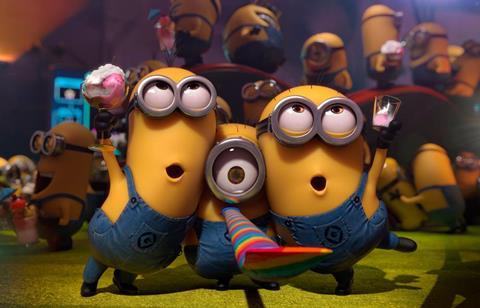

The tender bond that forms between Gru and his adoptive daughters, cemented with bedtime stories and spontaneous trips to a 3-D-maximizing amusement park, strives for a Pixaresque purity of feeling, while the winking, occasionally crude humor and pop-culture allusiveness, as well as Gru’s grumpiness, veer toward Shrekland.

It’s difficult not to see some of Gru’s inferiority complex reflected in the movie itself, which labors mightily to distinguish itself in a terrain dominated by Pixar and DreamWorks Animation.

Gru is an underachiever, a perpetual second-place finisher behind the smug Vector, with his family connections, his track suits, his modernist mansion and his repertory of inane, done-to-death catch phrases (“Boo-yah” and “That’s what I’m talkin’ about!”). Its vision of evil is a man with a pointy nose, an exotic accent and a turtleneck sweater who wants to snatch the Moon because his mommy never loved him enough. “Despicable Me,” its title notwithstanding, means no harm and tries so hard to be likable that you may hate yourself for hating it. Universal Pictures and Illumination EntertainmentĪre you choked up yet? Are you laughing yet? You might be before the picture is over, but only because the alternative would be the kind of snarling fury that would make you feel bad about yourself. Gru is equipped with a disapproving, emotionally distant mother (Julie Andrews) a wisecracking nemesis named Vector (Jason Segel) a grouchy old scientist sidekick (Russell Brand) and a swarm of cute little yellow minions, whose mostly nonverbal chirping and squeaking provide a heavy, derivative dollop of cuteness and merchandising opportunity.Īnd just in case those industrious little doodads (they look like extra-strength pain-reliever capsules with eyes and limbs) weren’t cute enough, the film supplies three adorable orphans with old-lady names who melt Gru’s stony heart not long after he adopts them. The movie relies on the funny voices of popular television and movie performers (many of them associated with other properties in the NBC Universal corporate family), most notably Steve Carell, who whimsically adopts a quasi-Russian accent in the role of Gru, a supervillain. If anything, it tries much too hard, stuffing great gobs of second-rate action, secondhand humor and warmed-over sentiment into every nook and cranny of its relentlessly busy 3-D frames. The difference between inspired creation and frantic pretending is the difference between magic and mediocrity, between art and junk, or to cite a conveniently available example, between “Toy Story 3” and “Despicable Me.”ĭirected by Pierre Coffin and Chris Renaud and produced by Universal Pictures and Illumination Entertainment a new player in the lucrative and competitive world of feature animation “Despicable Me” cannot be faulted for lack of trying. But children’s entertainment, made by grown-ups at great expense in anticipation of even greater profit, is another matter. Is there a meaningful distinction to be drawn between exercising the imagination and just making up a bunch of stuff? When it comes to children at play, probably not: the pleasure of inventiveness matters more than the quality of the particular inventions.


 0 kommentar(er)
0 kommentar(er)
